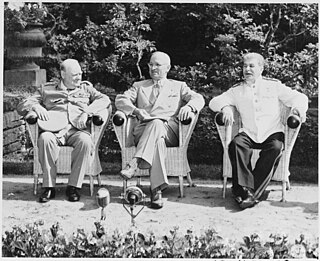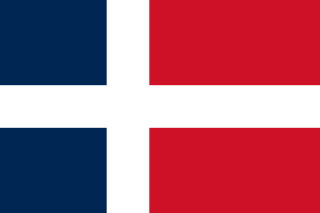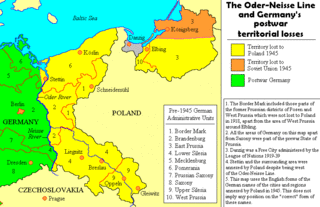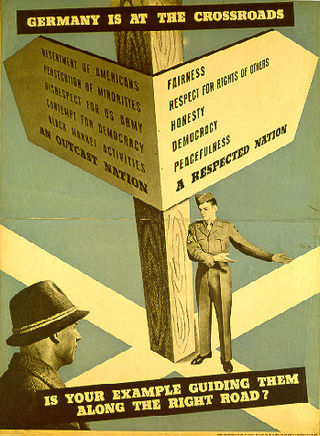
The Potsdam Conference was held at Potsdam in the Soviet occupation zone from July 17 to August 2, 1945, to allow the three leading Allies to plan the postwar peace, while avoiding the mistakes of the Paris Peace Conference of 1919. The participants were the Soviet Union, the United Kingdom, and the United States. They were represented respectively by General Secretary Joseph Stalin, Prime Ministers Winston Churchill and Clement Attlee, and President Harry S. Truman. They gathered to decide how to administer Germany, which had agreed to an unconditional surrender nine weeks earlier. The goals of the conference also included establishing the postwar order, solving issues on the peace treaty, and countering the effects of the war.

The Potsdam Agreement was the agreement between three of the Allies of World War II: the United Kingdom, the United States, and the Soviet Union after the war ended in Europe. It was signed on 1 August 1945 and published the next day. A product of the Potsdam Conference, it concerned the military occupation and reconstruction of Germany, its border, and the entire European Theatre of War territory. It also addressed Germany's demilitarisation, reparations, the prosecution of war criminals and the mass expulsion of ethnic Germans from various parts of Europe. France was not invited to the conference but formally remained one of the powers occupying Germany.

Denazification was an Allied initiative to rid German and Austrian society, culture, press, economy, judiciary, and politics of the Nazi ideology following the Second World War. It was carried out by removing those who had been Nazi Party or SS members from positions of power and influence, by disbanding or rendering impotent the organizations associated with Nazism, and by trying prominent Nazis for war crimes in the Nuremberg trials of 1946. The program of denazification was launched after the end of the war and was solidified by the Potsdam Agreement in August 1945. The term denazification was first coined as a legal term in 1943 by the U.S. Pentagon, intended to be applied in a narrow sense with reference to the post-war German legal system. However, it later took on a broader meaning.

The Yalta Conference, also known as the Crimea Conference, held 4–11 February 1945, was the World War II meeting of the heads of government of the United States, the United Kingdom and the Soviet Union to discuss the postwar reorganization of Germany and Europe. The three states were represented by President Franklin D. Roosevelt, Prime Minister Winston Churchill, and General Secretary Joseph Stalin, respectively. The conference was held near Yalta in Crimea, Soviet Union, within the Livadia, Yusupov, and Vorontsov palaces.

The history of Germany from 1945–1990 spans the period following World War II, from the Berlin Declaration marking the abolition of the German Reich and Allied-occupied period in Germany on 5 June 1945 to German reunification on 3 October 1990.

The Bizone or Bizonia was the combination of the American and the British occupation zones on 1 January 1947 during the occupation of Germany after World War II. With the addition of the French occupation zone on 1 August 1948 the entity became the Trizone. Later, on 23 May 1949, the Trizone became the Federal Republic of Germany, commonly known as West Germany.
Following the termination of hostilities in World War II, the Allies were in control of the defeated Axis countries. Anticipating the defeat of Germany and Japan, they had already set up the European Advisory Commission and a proposed Far Eastern Advisory Commission to make recommendations for the post-war period. Accordingly, they managed their control of the defeated countries through Allied Commissions, often referred to as Allied Control Commissions (ACC), consisting of representatives of the major Allies.
Demilitarisation or demilitarization may mean the reduction of state armed forces; it is the opposite of militarisation in many respects. For instance, the demilitarisation of Northern Ireland entailed the reduction of British security and military apparatuses. Demilitarisation in this sense is usually the result of a peace treaty ending a war or a major conflict. The principle is distinguished from demobilisation, which refers to the drastic voluntary reduction in the size of a victorious army.

The Soviet occupation zone was an area of Germany that was occupied by the Soviet Union as a communist area, established as a result of the Potsdam Agreement on 1 August 1945. On 7 October 1949 the German Democratic Republic (GDR), commonly referred to in English as East Germany, was established in the Soviet occupation zone.

The Saar Protectorate, officially Saarland, was a French protectorate and a disputed territory separated from Germany. On joining the Federal Republic of Germany in 1957, it became the smallest "federal state", the Saarland, not counting the "city states" of Berlin, Hamburg, and Bremen. It is named after the Saar River.

The reconstruction of Germany was a long process of rebuilding Germany after the destruction endured during World War II. Germany suffered heavy losses during the war, both in lives and industrial power. 6.9 to 7.5 million Germans died, roughly 8.26% to 8.86% of the population. The country's cities were severely damaged from heavy bombing in the closing chapters of the war and agricultural production was only 35% of what it was before the war.

The entirety of Germany was occupied and administered by the Allies of World War II from the Berlin Declaration on 5 June 1945 to the establishment of West Germany on 23 May 1949. Unlike occupied Japan, Germany was stripped of its sovereignty and former state: after Nazi Germany surrendered on 8 May 1945, four countries representing the Allies asserted joint authority and sovereignty through the Allied Control Council (ACC) under the Berlin Declaration of 5 June 1945 that led to the fall of the German Reich. At first, Allied-occupied Germany was defined as all territories of Germany before the 1938 Nazi annexation of Austria; the Potsdam Agreement on 2 August 1945 defined the new eastern German border by giving Poland and the Soviet Union all regions of Germany east of the Oder–Neisse line and divided the remaining "Germany as a whole" into four occupation zones, each administered by one of the Allies.
The formation of the European Advisory Commission (EAC) was agreed on at the Moscow Conference on 30 October 1943 between the foreign ministers of the United Kingdom, Anthony Eden, the United States, Cordell Hull, and the Soviet Union, Vyacheslav Molotov, and confirmed at the Tehran Conference in November. In anticipation of the defeat of Nazi Germany and its allies this commission was to study the postwar political problems in Europe and make recommendation to the three governments, including the surrender of the European enemy states and the machinery of its fulfillment. After the EAC completed its task it was dissolved at the Potsdam Conference in August 1945.

The industrial plans for Germany were designs the Allies of World War II considered imposing on Germany in the Aftermath of World War II to reduce and manage Germany's industrial capacity.

The Office of Military Government, United States was the United States military-established government created shortly after the end of hostilities in occupied Germany in World War II. Under General Lucius D. Clay, it administered the area of Germany and sector of Berlin controlled by the United States Army. The Allied Control Council comprised military authorities from the United States, the United Kingdom, the Soviet Union and France. Though created on January 1, 1946, OMGUS previously reported to the U.S. Group Control Council, Germany (USGCC), which existed from May 8, 1945, until October 1, 1945. OMGUS was eliminated on December 5, 1949, and the U.S. High Commissioner for Germany assumed control of its functions.
The administrative divisions of the German Democratic Republic were constituted in two different forms during the country's history. The GDR first retained the traditional German division into federated states called Länder, but in 1952 they were replaced with districts called Bezirke. Immediately before German reunification in 1990, the Länder were restored, but they were not effectively reconstituted until after reunification had completed.
The legal status of Germany concerns the question of the extinction, or otherwise continuation, of the German nation-state following the rise and downfall of Nazi Germany, and constitutional hiatus of the military occupation of Germany by the four Allied powers from 1945 to 1949. It became current once again when the German Democratic Republic joined the Federal Republic of Germany in 1990.
The Berlin Declaration of 5 June 1945 or the Declaration regarding the defeat of Germany, had the governments of the United States, the Soviet Union, the United Kingdom, and France, acting on behalf of the Allies of World War II, jointly assume de jure "supreme authority" over Germany after its military defeat and asserted the legitimacy of their joint determination of issues regarding its administration and boundaries prior to the forthcoming Potsdam Conference.

The Allied Control Council (ACC) or Allied Control Authority and also referred to as the Four Powers, was the governing body of the Allied occupation zones in Germany (1945–1949/1991) and Austria (1945–1955) after the end of World War II in Europe. After the defeat of the Nazis, Germany and Austria were occupied as two different areas, both by the same four Allies. Both were later divided into four zones by the 1 August 1945 Potsdam Agreement. Its members were the Soviet Union, the United Kingdom, the United States, and France. The organisation was based in Schöneberg, Berlin.
After World War II both West Germany and East Germany were obliged to pay war reparations to the Allied governments, according to the Potsdam Conference. Other Axis nations were obliged to pay war reparations according to the Paris Peace Treaties, 1947. Austria was not included in any of these treaties.














